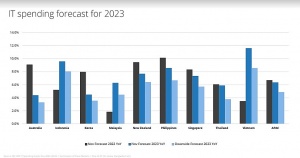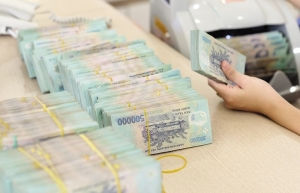Stimulation essential to boost demand, yet credit vigilance required
 |
| Pham The Anh |
Vietnam's GDP grew by a mere 3.72 per cent in the first half of this year, the lowest level since 2011, not including the pandemic years. How do you perceive the situation?
What is quite apparent is that the demand for exports, investment, and consumption is currently quite low.
The General Statistics Office figures show that in the first quarter of 2023, Vietnam’s total import-export value was down by more than 15 per cent on-year.
Exports sank, but imports also did and by a larger degree, resulting in an export surplus of $12.25 billion in the first six months of the year.
Production in Vietnam relies heavily on the import of materials, equipment, and technology, so while a large import surplus might not exactly be desirous, it indicates a very low demand for investment.
Low investment demand is also indicative of low credit growth, which stands at 3.13 per cent so far for the year, compared to over 8.5 per for the same period last year.
The decline in demand for consumption has been reflected in the slower growth in retail sales this year, just 11 per cent compared to 12.2 per cent for the first half of 2022.
Even this lowered growth has been supported by the nearly 5.6 million foreign visitors welcomed by Vietnam so far in 2023, representing a near ten-fold increase when compared to a year ago. Without these additional visitors, we could expect consumption to have slid even further.
Do you agree that the investment demand in the state sector, particularly regarding public investment, is a bright prospect?
It has been a positive factor during this period by virtue of the government’s wide-ranging measures and engagement with leaders from ministries, industry sectors, and localities to accelerate the disbursement of public investment to boost economic growth, in both the short and long term.
As a result, state investment has surged by 12.6 per cent, yet the private sector grew by just 2.4 per cent with foreign-backed investments expanding by 3.8 per cent.
If you were to take into account the inflation rate of around 3.3 per cent, the true value of the amount invested into the whole of society so far this year grew by a mere 4.7 per cent, less than half of the 9.2 per cent growth for the same period last year.
The government has pushed through several fiscal policies in a bid to fuel demand. Why have we yet to see any meaningful change?
Demand-stimulation policies often have a delayed reaction, meaning it takes time for the policies to generate practical effects, especially with the fairly recent enactment of these policies.
Late last year, I advised that it would be necessary to continue expediting fiscal and monetary policies into 2023 as had been done in 2022, while also taking the bold step to reduce regulatory interest rates to support recovery.
| Demand-stimulation policies often have a delayed reaction, meaning it takes time for the policies to generate practical effects. |
In fact, most fiscal policies for this year were enacted quite recently.
For instance, the 2 per cent VAT reduction and 50 per cent registration fee reduction for locally produced cars only came into force on July 1, whereas the lowering of regulatory interest rates began in the second quarter with a further four adjustments over the following three months.
While I believe there is great appreciation for the government’s efforts to reduce interest rates, as it helps firms to lower borrowing and production costs, it is more important for businesses to more easily gain access to capital sources.
Do you have any concerns over the loosening of monetary policies?
Looking back on the trajectory of Vietnam’s economic development, it is apparent that asset bubbles appear every five to seven years.
The cause behind the sharp rise in land, real estate, and securities can be traced back to the over-loosening of credit restrictions.
Once a huge volume of capital is pumped into the economy, without close supervision, large volumes might be channelled into the stock and real estate markets instead of feeding production and business demands, or supporting priority production areas.
Similarly, excessive fiscal policy loosening beyond the receptiveness of the economy might result in unfocused and less effective public investment, and it may take years to tackle the situation.
Overall, I consider the loosening of monetary policies and expansion of fiscal policies to be a smart move in the current climate, but it will require a lot of prudence if we are to learn from our previous lessons.
 | Essential digitalisation trends for reducing business costs Technology is the only way for businesses to achieve true cost reductions and resilience, according to an IBM media panel on December 2. |
 | Policies needed to boost production linkage, localisation rate: insiders Policies are needed to boost the number of domestic enterprises participating in the supply chain of multinational companies, and a boost is necessary in the localisation rate of the processing and manufacturing industry, which now remain modest, insiders said. |
 | 2 per cent reduction in VAT to boost aggregate demand The 2 per cent reduction in VAT is hoped to affect aggregate demand significantly, effectively doping the economy amidst the current slowdown. |
 | Vigilance over bad debt essential As bad debts continue to pose a threat to the banking sector's performance, financial authorities are implementing a host of measures to keep tabs on credit quality and mitigate risk to optimise the efficiency of credit institution restructuring. |
What the stars mean:
★ Poor ★ ★ Promising ★★★ Good ★★★★ Very good ★★★★★ Exceptional
Related Contents
Latest News
More News
- Businesses ramp up production as year-end orders surge (December 30, 2025 | 10:05)
- Vietjet chairwoman awarded Labour Hero title (December 29, 2025 | 13:06)
- How to unlock ESG value through green innovation (December 29, 2025 | 10:03)
- AI reshapes media and advertising industry (December 29, 2025 | 08:33)
- FPT and GELEX sign deal to develop blockchain tech for global markets (December 29, 2025 | 08:29)
- Vietnam’s GDP forecast to grow by 9 per cent in 2026 (December 29, 2025 | 08:29)
- Women entrepreneurs are key to Vietnam’s economic growth (December 29, 2025 | 08:00)
- Vietnam's top 500 value-creating enterprises announced (December 27, 2025 | 08:00)
- The PAN Group shaping a better future with ESG strategy (December 26, 2025 | 09:00)
- Masan Consumer officially lists on HSX, marking the next phase of value creation (December 25, 2025 | 13:20)

 Tag:
Tag:



























 Mobile Version
Mobile Version